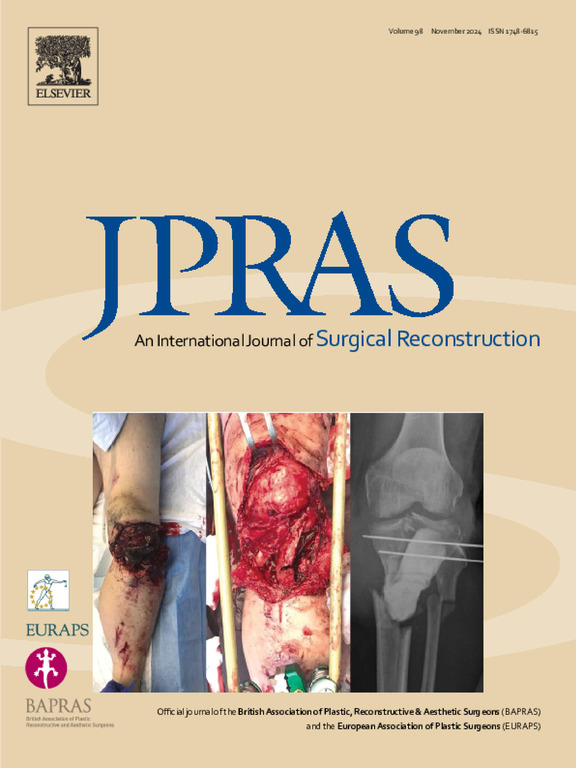Systematic review and meta-analysis of mobilisation following open reduction and internal fixation of hand fractures
IF 2
3区 医学
Q2 SURGERY
Journal of Plastic Reconstructive and Aesthetic Surgery
Pub Date : 2025-05-12
DOI:10.1016/j.bjps.2025.05.006
引用次数: 0
Abstract
Delayed mobilisation following open reduction and internal fixation (ORIF) of hand fractures may contribute to stiffness and poor functional recovery. The aim of this systematic review and meta-analysis was to evaluate whether timing of mobilisation post-ORIF impacts patient-reported and clinical post-operative outcomes.
The review was conducted according to the Cochrane Handbook and was reported in concordance with PRISMA guidelines. All studies reporting mobilisation regimens following ORIF performed within two weeks of metacarpal or phalangeal fractures were included. Of 794 abstracts screened, 53 studies were included, evaluating 1822 hand fractures treated with ORIF.
We found differences between mobilisation timing in patient-reported outcome measures (PROMs), adverse events and time to radiological fracture union. Immediate mobilisation (≤1 day of ORIF) had the shortest mean bone healing time of 38.7 days (95% CI 34.3, 42.3) compared to early mobilisation (≤7 days) (49.6 days [95% CI 42.8, 56.5]). Delayed mobilisation (>7 days) had the lowest rate of adverse events at 9.3% [95% CI 5.6, 15.2] compared to early mobilisation at 25.0% [95% CI 17.1, 35.0]. However, variable outcome reporting and inconsistent diagnostic criteria limited definitive conclusions.
The current literature on post-ORIF mobilisation is heterogeneous. Our meta-analysis demonstrated wide variability in outcomes across different regimens, with overlapping confidence intervals across most summary estimates. A definitive, multi-centre RCT comparing time to mobilisation post-ORIF, including comprehensive outcome reporting and cost-effectiveness analysis, is warranted to inform clinical practice.
手部骨折切开复位内固定术后活动的系统回顾和荟萃分析
手部骨折切开复位内固定(ORIF)后延迟活动可能导致僵硬和功能恢复不良。本系统综述和荟萃分析的目的是评估orif术后活动时间是否影响患者报告和临床术后结果。根据Cochrane手册进行评价,并按照PRISMA指南进行报道。所有报告在掌骨或指骨骨折后两周内进行ORIF后活动方案的研究均被纳入。在筛选的794篇摘要中,纳入了53项研究,评估了1822例ORIF治疗的手部骨折。我们发现活动时间在患者报告的结果测量(PROMs)、不良事件和放射骨折愈合时间之间存在差异。与早期活动(≤7天)(49.6天[95% CI 42.8, 56.5])相比,立即活动(ORIF≤1天)的平均骨愈合时间最短,为38.7天(95% CI 34.3, 42.3)。延迟动员(7天)的不良事件发生率最低,为9.3% [95% CI 5.6, 15.2],而早期动员的不良事件发生率为25.0% [95% CI 17.1, 35.0]。然而,不同的结果报告和不一致的诊断标准限制了明确的结论。目前关于orif后动员的文献是异构的。我们的荟萃分析表明,不同方案的结果存在很大的差异,大多数汇总估计的置信区间重叠。一项明确的多中心RCT比较orif后动员时间,包括全面的结果报告和成本效益分析,有必要为临床实践提供信息。
本文章由计算机程序翻译,如有差异,请以英文原文为准。
求助全文
约1分钟内获得全文
求助全文
来源期刊
CiteScore
3.10
自引率
11.10%
发文量
578
审稿时长
3.5 months
期刊介绍:
JPRAS An International Journal of Surgical Reconstruction is one of the world''s leading international journals, covering all the reconstructive and aesthetic aspects of plastic surgery.
The journal presents the latest surgical procedures with audit and outcome studies of new and established techniques in plastic surgery including: cleft lip and palate and other heads and neck surgery, hand surgery, lower limb trauma, burns, skin cancer, breast surgery and aesthetic surgery.

 求助内容:
求助内容: 应助结果提醒方式:
应助结果提醒方式:


